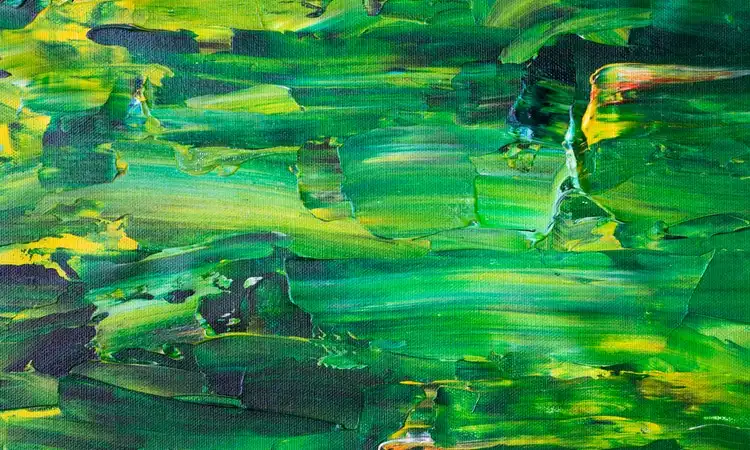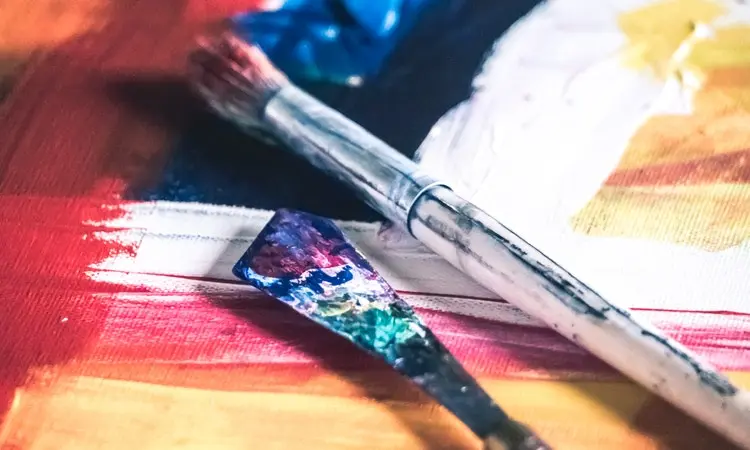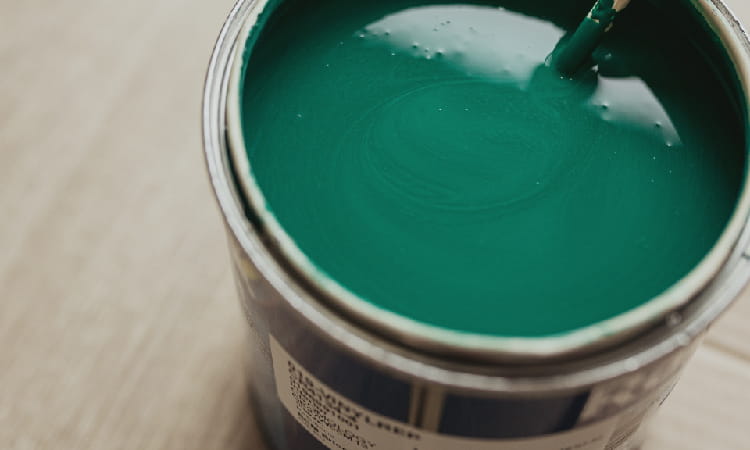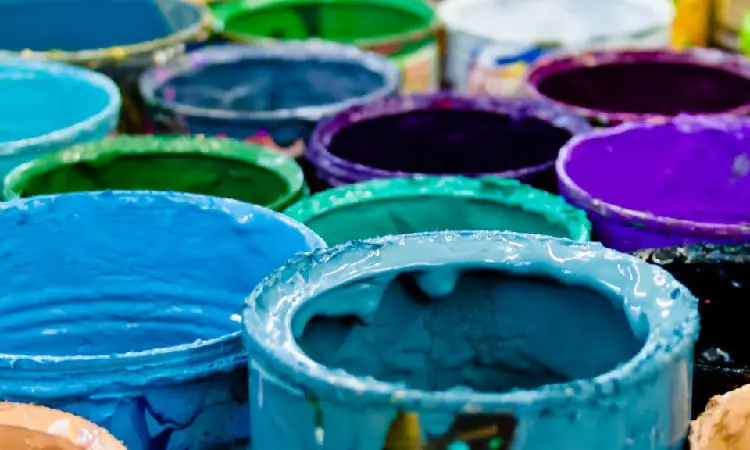Artists thicken acrylic paint to produce a unique type of painting through the impasto technique. Other users increase acrylic paint’s viscosity to reduce the number of coats.
There are several ways to thicken acrylic paint. You can use any thickening materials, but you must not destroy the paint’s integrity.
The products you can use to thicken acrylic paint include modeling paste, acrylic gel mediums, and joint compounds. You can also use home products, such as baby powder, baking soda, cornstarch, and flour. The general process is to evenly mix the thickener directly into the paint in a small amount until you achieve your desired consistency.
You should not worry so much if you have thin or runny paint. Don’t think of throwing it because you can still salvage it. You might also find the thickening process fun.
As to which thickener you use, it is solely up to you. Continue reading to learn how to use the various products to thicken your acrylic paint.

Can You Make Acrylic Paint Thicker if it is Too Thin?
Have you ever wondered how artists create intricate paintings and art using acrylic paint?
Those detailed strokes and features may not be possible without altering the paint to make it more viscous or thicker.
As you may have figured already at this point, the answer is YES – you can thicken acrylic paint! It is a matter of choosing from the various thickeners available.
Each thickener has different characteristics that can influence the quality of the paint. I will try to cover this point in the succeeding sections.
Another important consideration when you thicken acrylic paint is to ensure that you do not ruin the paint.
Using incompatible thickeners can make your paint useless. Using specialized thickening gels is a good option if you want to ensure that the paint’s properties are not affected.
If you do not want to hassle yourself with going to the store to purchase a gel medium, you can always go for home alternatives.
However, you need to understand that using these thickeners may affect the durability of your acrylic paint. Using cornstarch or flour will work, but it is prone to developing molds.
What Mediums Thicken Acrylic Paint?
There are different types of acrylic mediums, including gloss, matte, glaze, gel, modeling paste, texture gels, retarding medium, and flow improver.
Not all acrylic mediums can assist you in thickening your paint. The common mediums used for paint thickening are gel medium and modeling paste.
I will discuss modeling paste and gel mediums below. As a bonus, I will also include some points on using joint compounds as paint thickeners.
These products may differ in texture and consistency, but they all work effectively. Learn more information about these thickeners and how you can prepare them.
Modeling Paste
A good alternative to thicken your acrylic paint is modeling paste.
Although it can be slightly challenging to mix due to its texture, the result could be good.
This thickener can also make your acrylic harder and allows you to sand or carve when the paint dries.
However, modeling paste may alter the color of your paint due to its natural white color.
You will need a putty knife to mix the thickener with your acrylic paint.
Add a small amount of paste each time and mix it evenly with the paint solution until you achieve your desired level of thickness.
Because of the natural thickness of the modeling paste, you can adjust the paint’s texture very well. If you are an artist, it will allow you to create intricate 3D patterns.
If you decide to use this as your paint thickener, you might be interested in knowing the best modeling paste on the market.
There are many options you will find online, like these collections from Art News. If you are not a fan of online shopping, you can check out your local hardware or paint stores.
Acrylic Gel Medium
Many artists prefer using an acrylic gel medium and consider it one of the most effective thickeners.
Gel medium is a white-colored paste produced for thickening paints.
This product is available in different types like gloss and matte.
Gel medium is one of the most effective acrylic paint thickeners. Aside from it being 100% compatible, it also enhances adhesion.
Furthermore, it allows the user to apply the impasto technique with so much ease.
Similar to the modeling paste, you will need the help of a palette knife to mix it with the paint. See the step-by-step process below for your guide.
Materials You Need:
- Acrylic gel medium
- Putty or palette knife
- Palette or mixing plate
Step 1: Prepare your paint. Spread your paint on your palette or dish using your palette knife. Mix your colors first if you deal with multiple colors and scatter the paint.
Step 2: Add the gel. The ideal amount of gel to add is 1/4 of the paint so that the paint will not become unstable. However, you can add less if you desire.
Step 3: Mixing time. Start mixing the gel into the paint using your palette knife. Ensure that the gel is evenly blending into the paint. Alternatively, you can also use your brush to do the mixing.
Joint Compound
I added the joint compound in this section because it is more appropriate. I don’t want to add it to the home remedies because it may not necessarily fall under that category.
It is good to know that you will not run out of options to thicken your acrylic paint. If you dislike modeling paste or gel medium, a joint compound is available for you to try.
If you are wondering what it is, it is the white powder that your handyman uses to seam and smoothen your walls or seal wall joints.
You might think that a joint compound is the same as a spackle. They are different. The former is for finishing touches, while the latter is for filling holes and surface imperfections.
You can also use spackle as a thickener, but the quality will not be as good as what you get if you use joint compound.
Now, let’s talk about how to proceed with the thickening of your acrylic paint. There is nothing difficult at all.
You can directly mix a small amount of the compound at a time into the paint and mix it well until you achieve the thickness you desire. You can use a palette knife or your brush to do this.
How to Thicken Acrylic Paint with Household Items
For anything that we do, we always ask whether there is a product we can find in the corners of our homes to substitute what we need. We can always make small compromises.
If you are creating artwork on a canvas at home and you don’t want to go out to look for thickeners, there are various household items you can use.
Your kitchen must-have baking soda, cornstarch, or flour. You can also consider your baby’s talcum powder if you prefer.
Many people use these products to thicken their paint when they have house painting jobs.
Artists also use these products as substitutes for acrylic mediums. Take a further read below to know more about how they work.
Baking Soda
Baking soda has a wide range of uses aside from food. One is to use it to thicken your acrylic paint.
Mixing it with your paint solution allows you to create a thick and fluffy product.
The only downside of using it as a thickener is the possibility of developing mildew. It means the paint will not last very long.
To start the process, pour the paint into a mixing container.
Then, add a quarter cup of baking soda into the container and stir the solution until you see that it has completely blended.
You might need to add more powder, depending on the volume of the paint. You can check this video to see a demonstration.
Cornstarch
So, you thought cornstarch is used only for your fried chicken? Well, it is another accessible option to thicken your acrylic paint.
Many artists have embraced cornstarch as a good thickener. The thickening process is simple.
Get your mixing container and fill it with one and a half cups of water. Then, add two tablespoons of cornstarch into the water and stir until it dissolves.
Heat the mixture until it becomes thicker, then let it cool down. Finally, mix the cornstarch paste into your acrylic paint and stir until you achieve the right level of consistency.
Flour
You can also use flour to thicken your acrylic paint. The process is very similar to using cornstarch.
The result of using flour to thicken your paint is very similar to the product when you use an acrylic thickening gel medium.
It is indeed an affordable and quick method you can try.
Here is how you can use flour as a thickener for your acrylic paint:
Materials You Need:
- 2 Tablespoons of flour
- Mixing bowl
- Water
- Heating pan
- Stirrer
- Mixing container to mix the flour and the paint
- Gas stove
Step 1: Measure the flour. Measure two tablespoons of flour. This amount should be enough to create a paste you can use as a thickener for your paint.
Step 2: Put the flour in the mixing bowl. Put a cup of water in the mixing bowl and add the two tablespoons of flour. Stir it well to distribute the powder in the water evenly.
Step 3: Heat the flour-water mix. Turn your gas stove on and set it to low heat. Transfer the flour-water mixture into the heating pan and put it on the stove.
Step 4: Stir the mix. Stir the mix continuously and consistently, as you do when you make gravy. This ensures that you achieve a lump-free paste. Continue until you achieve the level of thickness you want.
Step 5: Let it cool. Turn off the gas stove and let the flour paste cool. You might need to continue stirring for it to cool off more quickly.
Step 6: Mix the paste into the paint. When the flour has cooled off, prepare the mixing container containing your acrylic paint.
Add the flour paste to the paint and do the stirring job again. Check the texture until you are sure that the flour and the paint have blended.
Baby/Talcum Powder
There is no need to go to the store to purchase a thickener for your acrylic paint if you have talcum powder at home.
The preparation is straightforward. See the steps below.
Materials You Need:
- Cup of baby or talc powder
- Mixing container
- Paint stick/stirrer
Step 1: Prepare the baby powder. Measure a cup or a cup and a half of the talcum.
Step 2: Prepare your acrylic paint. Pour your paint into a mixing container to comfortably stir the solution.
Step 3: Add the baby powder to your acrylic paint. Add the powder into the container where you poured the paint solution.
Step 4: Stir. Stir until you reach the desired level of consistency.
Things to Know to Not Damage Your Acrylic Paint while Thickening it

It is best to briefly talk about the nature and characteristics of acrylic paint before anything else.
What is acrylic paint? It is a type of paint in which the main solvent is water. This formula is capable of withstanding exposure to sunlight o ultraviolet.
Generally, acrylic paints are highly elastic and durable. They also include anti-color fading properties. Because of the performance that this type of paint promises, it is a little expensive.
Therefore, you need to ensure that you are handling it properly to avoid wasting resources.
The least you want is to damage your paint after you thicken it. It is a waste of effort and resources when that happens.
How do you ensure that you’re not damaging your acrylic paint?
Below are some things you should know to prevent any damage.
- Think about how the thickener affects the color of the paint. Some of the thickeners I feature here are white. You need to acknowledge that when you add these particles to the paint, the color will become lighter. Therefore, consider your color preference when thickening your acrylic paint.
- Stir the paint well. Don’t be lazy ass when thickening your acrylic paint. You need to ensure that you stir it well enough to evenly distribute the thickener into the paint solution.
- If you use baking soda or flour as thickeners, you need to heat them first. They are different from other commercial thickeners. Adding them directly to the paint solution may create unwanted lumps.
- Add thickeners in portions. It is ideal for measuring the thickener you add to the paint. Putting too much thickener in the paint may cause it to become too sticky and hard to manage. You don’t want to add paint thinners afterward. That sounds crazy, and it will damage the overall integrity of the paint.
- If you purchase gel mediums, ensure that it is for acrylic paint. There are also other products dedicated to other types of paint.
FAQs: Thickening Acrylic Paint
1. Can you use baby powder to thicken acrylic paint?
Baby or talcum powder is a good option to thin your acrylic paint.
It produces a result that is closely similar to what you get when you use acrylic gel mediums.
The thickening process is also simple. You simply add the powder to the paint and stir the solution.
2. Can you thicken acrylic paint with baking soda?
Baking soda is also a good substitute for acrylic gel mediums. There is no need for you to go out anymore if you have a jar of baking soda in the kitchen.
Surprise yourself with a fluffy and thick acrylic using baking soda. However, you must ensure not to add the powder directly to the paint.
You need to heat it in a pan with constant stirring to obtain a soda paste.
3. Does glue thicken acrylic paint?
Generally, PVA glue will not work as a thickener for acrylic paint. Although it might still mix with your paint solution, it will not give you the result you want to achieve.
However, some people use PVA glue in combination with talcum powder.
Mixing glue with acrylic also requires extra care. Otherwise, you might damage the paint completely.
4. Can you thicken acrylic paint with flour?
Flour is another acrylic paint thickener substitute. It works similarly to baking soda. The thickening preparation process is also the same.
You need to put a couple of tablespoons into tap water and stir it really well. Then, heat the solution in a frying pan. Let it cool down before you mix it with the paint.
Verdict
There are many ways to thicken your acrylic paint. There are many products you can use, including specialized paint thickeners or home remedies.
You can use acrylic gel mediums, modeling paste, joint compounds, baby powder, baking soda, cornstarch, and flour.
The best thickeners for me are still those produced by paint experts, such as acrylic get mediums.
Although it can be a little more costly than home remedies, you can be confident that it doesn’t disturb so much the paint properties.
Don’t get me wrong. Using home remedies like baking soda, flour, and baby powder is fine. The result would look very similar.
However, they might not have the same quality. Since cornstarch and flour come from plants, it is likely to develop molds or mildew. Therefore, the life span of the paint will be shorter.






